Chinese Jade
General Introduction
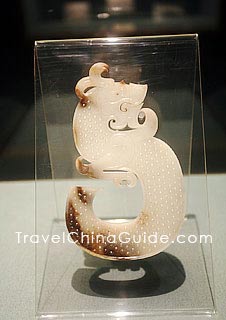 |
| Jade Dragon |
In Chinese, jade is pronounced as 'Yu', and most words related to moral include this word such as 'Unpolished jade never shines,' indicating that one cannot be a useful person if he is not educated. It also implied honor and conviction. Many girls in ancient times were also named with jade to reflect the love of their parents. One of the Four Beauties in Chinese history, Yang Yuhuan, the beloved concubine of Emperor Xuanzong in the Tang Dynasty (618 - 907), was their representative. Yang is her surname and her given name Yuhuan means simply 'jade ring'.
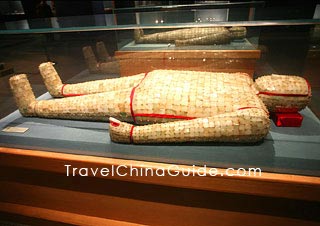 |
| Jade Garment Knitted with Fine Gold Wire |
Jadeite
Nephrite Jade
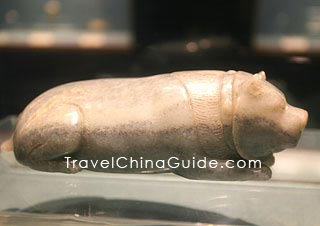 |
| Jade Bear |
In China, the most reputable jade producing area is Hetian in Xinjiang Province. Hetian jade is so hard that it can scratch glass. It has often been found in very huge pieces. An example of this is the huge jade hill on which the grand scene of Yu the Great leading people to control flood is elaborately carved. It was 5,350 kg weight (11,795 pounds) when it was completed. Now this artwork is displayed in the Forbidden City.
Serpentine jade, or Xiu yu in Chinese, is mainly from Xiuyan County in Liaoning Province. Made of many different ingredients, it takes on various appearances: white, yellow, light yellow, pink, green, dark green, light green and so on. This type is usually coloured in various shades of green. Usually serpentine jade is semi-transparent or even opaque like wax.
Lantian jade is produced in Lantian County, north of Xi'an in Shaanxi Province. It was also among the most charming ancient jades, for its rigidity made it easier to be carved into decorations and jewelry by our ancestors. The hue is uneven in colors of yellow or light green.
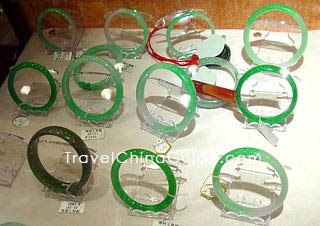 |
| Jade Bracelets |
Nanyang County in Henan Province is famous for its abundant Nanyang jade. The ore district is located on an isolated 200 meter high hill, called Dushan Hill (thus its other name of 'Dushan jade'). It is distinctive for its whimsicality. Among the Nanyang jade artworks, you will find rare purple, blue and red ones.
Appreciation and Maintenance
To obtain a real and choice jade article, you should take pains to learn and appreciate it. The criteria lie in the brightness of color and luster, compactness of inner structure, and the delicacy of the craftwork. For example, nephrite creates an oily luster and jadeite creates a vitreous luster. Tiny cracks can lower its value; on real one, air bubbles cannot be seen; the more lenitive the higher quality of jade, and so on.
Having purchased a jade article is just half the process of collecting. It is like a child that needs constant care. Enthusiasts need to work more to maintain this artwork, or blemishes may appear.
![]() First, avoid bumping on hard surfaces as it is delicate. Although sometimes a crack cannot be seen by the naked eye, the interior structure may have been damaged. As time goes on, it will appear and reduce the value of the piece.
First, avoid bumping on hard surfaces as it is delicate. Although sometimes a crack cannot be seen by the naked eye, the interior structure may have been damaged. As time goes on, it will appear and reduce the value of the piece.
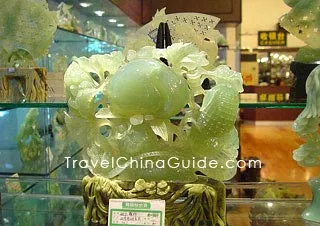
![]() Second, protect it from dust or greasy dirt. If tainted, they must be scrubbed with a soft brush and light suds and washed with clean water.
Second, protect it from dust or greasy dirt. If tainted, they must be scrubbed with a soft brush and light suds and washed with clean water.
![]() Third, when left unused it is best to store the it in a case or box to protect it from being bumped.
Third, when left unused it is best to store the it in a case or box to protect it from being bumped.
![]() Fourth, it should be kept away from perfume, perspiration or chemicals. Its brightness risks corrosion, especially emerald and other high quality jade, so it is better to clean it with a soft cloth after wearing it.
Fourth, it should be kept away from perfume, perspiration or chemicals. Its brightness risks corrosion, especially emerald and other high quality jade, so it is better to clean it with a soft cloth after wearing it.
![]() Fifth, do not expose it to sunlight for a long time, or it may expand and the quality will change slightly.
Fifth, do not expose it to sunlight for a long time, or it may expand and the quality will change slightly.
![]() Finally, jade has certain water content so keep it in an area of humidity to protect it from over-drying.
Finally, jade has certain water content so keep it in an area of humidity to protect it from over-drying.![]() Further Reading:
Further Reading:
Hindustan Jade Bowl in Treasure Gallery of Forbidden City